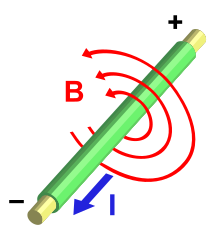Oersted's law
This article may have misleading content. (October 2023) |

In
This was discovered on 21 April 1820 by Danish physicist
compass
next to a wire carrying current turned so that the needle was perpendicular to the wire.
Ørsted investigated and found the physical law describing the magnetic field, now known as Ørsted's law.
Ørsted's discovery was the first connection found between electricity and magnetism, and the first of two laws that link the two; the other is Faraday's law of induction.
These two laws became part of the equations that govern electromagnetism, Maxwell's equations.
Ørsted's rules
Ørsted found that, for a straight wire carrying a steady direct current (DC):[5]
- The magnetic field lines encircle the current-carrying wire.
- The magnetic field lines lie in a plane perpendicular to the wire.
- If the direction of the current is reversed, the direction of the magnetic field reverses.
- The strength of the field is directly proportional to the magnitude of the current.
- The strength of the field at any point is inversely proportional to the distance of the point from the wire.
Direction of the magnetic field
right hand rule
to find the direction of the magnetic fieldThe direction of the magnetic field at a point, the direction of the arrowheads on the magnetic field lines, which is the direction that the "north pole" of the compass needle points, can be found from the current by the
conventional current
, flow of positive charge), the fingers will curl around the wire in the direction of the magnetic field.
Vector form of the law
The above rules can be generalized to give the modern vector form of Ørsted's law[2][6]
The line integral of the magnetic field around any closed curve is proportional to the total current passing through any surface bounded by the curve.
- where = 4π×10−7 V·s/(A·m) is the magnetic constant, and the direction of integration around is related to the direction of current by the right hand rule. The law can be expressed in terms of the current density through the surface instead of the total current through it[2]
- where is any surface spanning .
Ørsted's law only holds for steady currents, which don't change with time. Therefore, it only holds for DC
Ampere–Maxwell equation
.
Footnotes
- ^ Presentation (2015) by O. Zajkov, Physics Institute, Ss. Cyril and Methodius University of Skopje, Macedonia.
- ^ ISBN 978-0486318509.
- ^ Oersted, H. C. (1820). "Experiments on the effect of a current of electricity on the magnetic needles". Annals of Philosophy. 16. London: Baldwin, Craddock, Joy: 273.
- ISBN 0521356857.
- ISBN 0074515861.
- ISBN 978-0123846549.
References
- F. W. Sears and M. W. Zemansky 1964 University Physics Third Edition (Complete Volume), Addison-Wesley Publishing Company, Inc. Reading, MA, LCCCN: 63-15265 (no ISBN).








